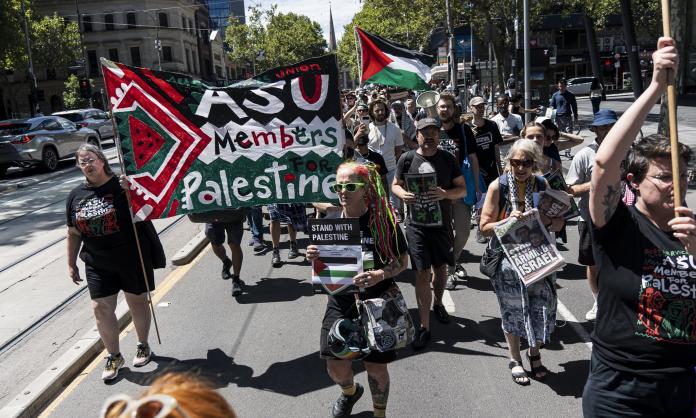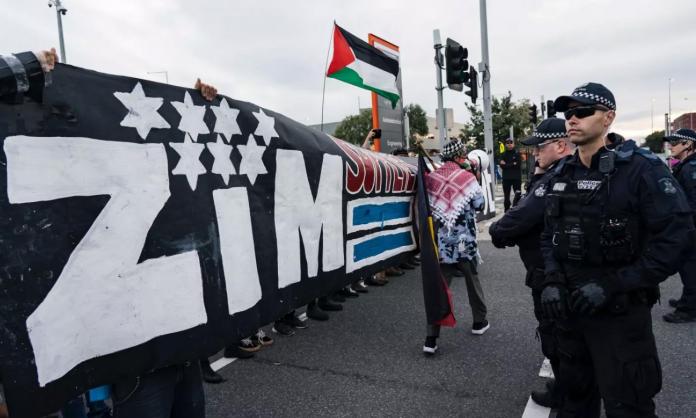In a darkened cinema in Buenos Aires, a film about the 2001 economic crisis and the romantic importance of tango music is about to begin. But first comes an advertisement for the National Institute of Cinema and Audiovisual Art, which runs the state-owned cinema. The crowd cheers: they reject its impending privatisation.
At the end of the ad is a clip from a popular anti-dictatorship film, Argentina 1985. “Nunca mas”, (“never again”) says the actor, ending a speech condemning the dictatorship, which ended in the 1980s with the promise of a new, democratic and more equal society.
The phrase is associated by many with the democratic rights that were won when the dictatorship fell: the right to strike, the right to assemble freely and carry out political debate, the right to cultural institutions that produce politically diverse films, art, television shows and news.
All of this is now under threat by the new far-right government of Javier Milei, who proposes a total restructure of society in favour of the rich. “Nunca mas”, the crowd mutters in the dark.
There’s a new cycle of struggle beginning in Argentina, sparked by Milei’s offensive. There is a lot at stake. Argentina’s rich are trying to defeat the Argentinian working class in the way that Margaret Thatcher defeated English workers in the 1980s, opening the path to a wholesale reconfiguration of the economy. Previous governments have attempted to do the same, and some have had important wins against the workers’ movement. But none of them have been able to complete the reconfiguration because they’ve been stymied by mass, popular movements.
The country has gone through successive cycles of struggle since the fall of the dictatorship in the 1980s, as governments attempted to press back on the plethora of social and economic rights that have been won over years. The biggest of these culminated with a nearly revolutionary situation in 2001. In this sense, the country is somewhat comparable to France, where the workers’ movement has stalled attacks by the capitalist class many times over the past two decades.
While previous Argentinian governments have implemented anti-worker economic measures, they have not achieved the wholesale restructure in favour of the rich that most Western countries have experienced over the last 50 years. Despite a poverty rate of 40 percent, the list of social democratic rights that exist in Argentina is huge. The right for workers to strike is enshrined in the constitution, unlike in Australia, where strikes are illegal except in very specific circumstances and only with the permission of the industrial court.
Argentina still has a large apparatus of state-owned corporations, including an oil company, a cinema complex and film production company, banks and an important airline. Higher education is free for domestic and international students, and for many courses there is no examination or secondary education score required for entry. In workplaces with a union-negotiated agreement, all workers are automatically union members and pay dues. The police do not usually use violence against protests because of a fear, learned through experience, of sparking new mass movements.
At the same time, the country is in an extremely deep economic crisis, which has been ongoing for years. Argentina finished 2023 with an annual inflation rate of more than 200 percent and the government owes billions to the International Monetary Fund.
Milei has put through two packages of bills, which will make it easier to sack workers, open nearly every state-owned corporation to privatisation and change the pension system, among other things. He’s coupling these economic attacks with an attempt to curtail civil liberties, including restricting the right to strike and introducing prison sentences of up to six years for those who protest. The packages exemplify the attitude of the rich: “Rip it all up and start again”.
The fight for leadership
The struggle so far has not been an unstoppable train of spontaneity. In November, 55 percent of the population voted for Milei, including many workers. Many are hesitant to fight against the government this early in his tenure. There are elements of spontaneity—for example, the night Milei’s first package of attacks was announced, more than 100,000 people took to the streets across the country banging pots and pans in protest. But since then, all of the sizeable demonstrations have been organised by the left, the unions and other organisations representing oppressed layers of society.
The main union federation, the General Confederation of Workers (CGT), has called a 24-hour general strike on 24 January. Mass mobilisations are planned in all cities. The strike will shut down much of the country and was called in response to pressure from workers and the demands of the country’s socialist parties.
The CGT is led by people politically aligned with the Peronist Justice Party, which governed Argentina in the years leading up to Milei’s election, and which forced workers to bear the brunt of the economic crisis gripping the country. Peronism takes up almost the entire political space in Argentina—social democracy, the centre left and the centre right. It also dominates the trade union bureaucracy. During the last Peronist government, headed by Alberto Fernandez, the CGT leaders refused to fight seriously for salary increases.
They have been attempting to negotiate with the government, and it would be naive to think that they will continue a serious fight if Milei offers some concessions. Many workers are conscious of this. At the first night of mass spontaneous demonstrations, one of the more popular chants was: “Where is it? We can’t see it! The famous CGT”.
Among more left-wing sectors of workers, a debate has been playing out about whether join the official CGT contingent of the strike march or to join an independent multi-sectoral column within the march, led by the socialist left. This is not just a debate about physical positions in the demonstration, but about whether or not there needs to be an alternative leadership of the struggle that can operate independently of the CGT.
This left column will be made up of the revolutionary socialist political parties, human rights organisations, neighbourhood assemblies, left-wing workers and radical sections of the unemployed workers’ movement (known as “piqueteros” because they regularly protest by picketing roads).
An assembly of more than 600 cultural workers and students in Buenos Aires on 20 January voted to march with an independent left-wing section of the strike demonstration. The assembly broke into four smaller groups, called commissions, and a separate student commission. Each of these had a long debate about whether to trust the CGT, the need for political independence from its leadership and how to keep the fight going after the strike.
The Workers’ Socialist Movement (MST), a Trotskyist party, led the argument that the workers should march with the left instead of with the CGT. They argued that this should be seen as part of a positive process of constructing a larger scale left-wing leadership in the struggle. The party chaired two of the commissions and were backed by most of the other left organisations and many independent activists. The argument for marching with the CGT was led by worker activists who are politically close to the CGT leaders, and the Party of Socialist Workers (PTS), another Trotskyist party.
At the end of the debates, each of the four commissions voted on a set of motions. In total, 364 people voted to march with the left column, 300 voted to march with the CGT and 13 voted to march in an autonomous column separate from both. The same day, an assembly of tyre factory workers and unemployed workers also voted join the left column. Since then, other organisations have voted to march with the left, including the most prominent abortion rights organisation in the country, which decided to follow the cultural workers.
The multi-sectoral column was planned at a mass meeting on 17 January, led by Syndicalismo Combativo (“Combative Unionism”), a broad front of all of the union delegates from the various revolutionary socialist parties, which has existed since 2017. More than 200 people attended, all representatives of specific organisations or assemblies. The planning discussion went for around two hours, with interventions by representatives of socialist organisations, independent unions, retirees groups, community and social justice campaigns, unemployed workers’ organisations and neighbourhood assemblies.
While the left regularly marches in their own column at demonstrations, there are more groups than usual planning to march alongside them on the day of the strike. The scale of the planned column is a significant shift from recent years. The struggle against Milei’s attacks is likely to go on for a long time, and the purpose of the independent column is to build a leadership that can continue the struggle irrespective of what the CGT leaders do. The vote by the cultural sector workers is particularly important because they have become a focal point for the struggle since Milei’s election.
The cultural sector surges
On the night of 10 January, thousands of cultural workers protested outside the Congress in Buenos Aires. Similar protests took place in more than 40 places around the country. In the context of Argentina’s historic mass movements, they were not huge. But they were the first round of demonstrations of the new year.
The protests were organised by workers’ assemblies. An assembly of more than 3,000 flooded the Plaza of the Memory of Argentine Theatre in Buenos Aires in late December. In the smaller cities, there were assemblies of 1,000 people in Córdoba, 500 in Rosario, 400 in Mendoza and similar numbers elsewhere. Assemblies convened over the next two weeks as the night of protest drew closer.
The cultural sector’s readiness to fight hasn’t come from nowhere. In 2021-22, workers fought to secure funding after the government voted to allow the previous arts funding agreement to expire. This process of struggle established a practice of holding assemblies and marches, and a sense of confidence.
A committee, United for Culture, was formed to lead the fight. It is independent of the bureaucracy that runs the unions and is made up of elected delegates from some of the state-run workplaces, leaders of a prominent organisation representing female actors and representatives from various other arts institutions. Revolutionary socialists play an important role leading the committee, which convened a series of open cultural worker assemblies and protests, some of which had to stand up to police repression. After months in the streets, they won 50 years of funding for state-backed cultural institutions. This gave credibility to the committee and created a sense among the workers that if they fought, they could win.
It is an example of how partial struggles in individual sectors can contribute to broader class struggle. But it didn’t happen automatically. United for Culture was initiated and is still partially led by Ingrid Urrutia, a member of the MST and the lead union delegate representing workers at the National Institute of Cinema and Audiovisual Art. Her political opposition to the union bureaucracy, and her willingness to act when they refuse to, have been important for shaping the politics of the committee.
After Milei was elected, both major unions that represent state employees failed to mobilise for weeks, despite it being clear that the new government was preparing for mass lay-offs.
“UPCN [Union of the Civil Personnel of the Nation, a public sector union] argued that we should not go out and confront anything because we must respect the democratic will of what the people voted for”, Urrutia said in an interview with her socialist organisation’s publication. “At [the National Institute of Cinema and Audiovisual Art] they said, literally, that the workers do not have to do anything because [the union leaders] are going to fix everything ‘over coffee’ with the incoming management ... But workers don’t eat glass; the leadership is one thing and the base is another.”
The other public sector union, the Association of Government Workers, initially called for a protest, but cancelled it just three days before it was meant to happen. In contrast, shortly after Milei was elected, United for Culture held an assembly of around 200 people, which voted on a resolution stating: “We declare ourselves in a state of alert and call for mobilisation ... and demand that union leaders organise resistance”. The assembly voted to join a mass march against Milei, which had been called by the left parties for 20 December.
While all workers face general attacks, the sharpest and most immediate are directed at state workers, who face 7,000 layoffs.
Already, the government has sacked many workers by refusing to renew their contracts in the new year. According to a press release by the Association of Government Workers, 182 Ministry of Culture workers were laid off in early January. Many more will follow if the government gets its way. Some contracted workers are facing an immediate pay cut of up to 50 percent through loss of overtime.
The government wants to close the National Theatre Institute and the National Fund for the Arts, which fund exhibitions, festivals and contests and provide subsidies and scholarships for artistic work. There is also a proposal to defund the National Institute of Cinema and Audiovisual Art, the National Institute of Music and the National Commission of Popular Libraries. As well as their important cultural roles, these institutions are huge employers, with thousands of workers.
Many public sector workers want to fight. But the bureaucracy that leads the Association of Government Workers has dragged its feet. The union held a protest on 15 January. But it was at 11am on a workday, and the union leaders insisted that no-one should leave work to join it. This blocked most state workers from attending. As a result, the turnout was only 1,000. In an assembly of more than 100 workers at the Ministry of Women on 12 January, many had argued that the protest should be a strike so that they could all leave work and join it.
This is what makes the cultural workers unique. Other state workers do not have leadership committees independent of the union bureaucracy, like United for Culture.
One of the important tasks for the left is to establish an independent leadership reaching beyond the cultural sector, which could call actions if and when the CGT leaders fail to do so. That’s what the Syndicalismo Combativo coalition is designed to be. Building the independent multi-sectoral column at the demonstration on the day of the strike, led by Syndicalismo Combativo, will be important for giving the coalition greater legitimacy and creating that alternative pole.
As well as building the independent bloc, the main activities of the left for now are trying to get as many workers as possible to the 24 January general strike and putting forward action plans in particular sectors, with specific dates for protests and assemblies to build the movement’s momentum. Previous cycles of struggle in Argentina have gone on for many years before peaking. It’s possible that this one will be the same. If so, developing the leadership of the revolutionary left into a real political alternative will be important.











